Myth-Busting Smart Homes: 5 Common Misconceptions Renters Have About Energy-Saving Tech
Smart home technology that saves energy is popping up everywhere. You’ve probably seen something about smart bulbs, learning thermostats, or plugs that magically reduce your electricity bill. These gadgets promise lower utility costs and a greener lifestyle, but if you’re a renter, you might not be sure if they’re for you. After all, can you really install these devices in your apartment? Will you see real savings? Are they difficult to set up—or to remove when you move out?
Let’s tackle the top five misconceptions renters have about smart home energy tech. We’ll give you facts, tips, and actionable advice so you can make greener choices—without risking your security deposit.
1. Myth 1: “Smart Home Tech Is Only for Homeowners”
Why This Myth Exists
It’s easy to think smart home technology is only for those who own their own place. Many products are marketed to homeowners looking to add permanent value or features. There’s also a lingering sense that “installing” technology requires drilling, rewiring, or major changes—all a big no-no for renters.
The Reality: Renters Can Easily Use Smart Energy Tech
- No Permanent Changes Needed: A growing number of devices are designed to plug in, stick on, or screw in—no tools or landlord permission required.
- Easy to Move and Remove: Most smart gadgets can be taken with you when you move out. You simply unplug, unscrew, or peel them off.
- Wi-Fi and Battery Powered Options: Many devices don’t need hardwiring or access to your apartment’s circuit panel.
Actionable Tips for Renters
- Stick to plug-and-play products like smart bulbs, plugs, and portable thermostats.
- Use 3M Command Strips or adhesive pads instead of screws for mounting sensors or hubs.
- Keep the boxes and instructions so you can easily uninstall and take devices with you.
- If you need to make a change (like swapping a thermostat), ask your landlord first and offer to reinstall the old one when you leave.
2. Myth 2: “Smart Devices Won’t Save Much on My Energy Bill”
Why This Myth Exists
Skepticism is healthy. Are a few smart bulbs and a plug really going to make a dent in your utility bill? Media hype can feel disconnected from real life, especially in rentals where you may not control major appliances or the heating/cooling system.
The Reality: Renters Can See Real Savings
While it’s true you may not be able to upgrade the furnace or water heater, renters do have control over lighting, electronics, and small appliances. These add up!
- Lighting: Smart LED bulbs cut energy use by up to 80% compared to incandescents. Automated schedules and remote control help ensure lights aren’t left on by accident.
- Plugs and Power Strips: Smart plugs can cut “phantom” power use when devices are idle (like TVs, chargers, or game consoles).
- Temperature Control: Portable smart thermostats (or radiator controllers) help avoid overheating/cooling empty rooms.
How Much Can You Save?
- Switching to LEDs can save $75–$150 per year, depending on your use.
- Smart plugs and scheduling can save another $30–$100+ per year in reduced vampire power and forgotten devices.
- Smarter temperature control can cut your heating/cooling bill by 10–20%.
Actionable Tips for Renters
- Start with a few smart bulbs and plugs in high-use areas (living room, bedroom, kitchen).
- Take advantage of eco modes, energy reports, or usage tracking in apps—these features give you feedback for further savings.
- Use voice commands or routines to double-check everything is off when you leave home (Google Assistant, Alexa, etc.).
3. Myth 3: “Smart Devices Are Too Complicated or Require a Hub”
Why This Myth Exists
Not long ago, setting up a smart home did require technical know-how and a central “hub” (plus plenty of troubleshooting). For those who’ve tried—and failed—with early smart tech, the idea can still sound daunting.
The Reality: Most Modern Devices Are Plug-And-Play
- Wi-Fi Enabled: Today’s smart devices usually connect directly to your Wi-Fi network—no extra hub needed.
- App Setup: Setup is typically handled through a user-friendly smartphone app with step-by-step instructions.
- Voice Assistant Compatibility: Many smart products work with Alexa, Google Assistant, or Apple HomeKit out of the box.
Actionable Tips for Renters
- Choose products labeled as “hub-free” or “Wi-Fi enabled” for fastest setup.
- Download the app before purchase (check app reviews for user experience).
- If you have a smart speaker (Alexa/Echo, Google Nest, or Apple HomePod), look for products designed for that ecosystem for easier integration.
- Start with one or two devices—then expand your system as you learn.
Extra Tip: What to Do If Your Wi-Fi Is Weak
- Position your router centrally in your home.
- Consider a Wi-Fi extender or mesh system if your apartment is large or has thick walls.
- Avoid setting up too many devices at once if your internet service is slow.
4. Myth 4: “Smart Devices Aren’t Safe or Could Invade My Privacy”
Why This Myth Exists
It’s natural to be concerned about anything with a microphone, camera, or an internet connection in your home. News stories about hacking, privacy breaches, or smart home devices “listening in” can be unsettling.
The Reality: Smart Devices Can Be Safe With Smart Habits
- Reputable Brands Prioritize Security: Established brands update their products and patch known vulnerabilities.
- User Controls: Most devices let you control what’s shared, when, and with whom.
- No Camera/Mic Needed for Energy Savings: You don’t need a device with a camera or microphone (like a smart speaker or camera) to get energy-saving benefits. Smart plugs, thermostats, lights, and sensors don’t record audio or video.
Actionable Tips for Renters
- Buy from trusted brands with a record of supporting their products (see our recommendations below).
- Change default passwords and enable two-factor authentication if available.
- Regularly update your devices’ firmware/apps.
- Check app permissions—disable any that don’t make sense for you.
- Don’t buy more advanced monitoring cameras or microphones unless you understand and are comfortable with their features.
5. Myth 5: “Smart Home Upgrades Will Void My Lease or Risk My Security Deposit”
Why This Myth Exists
Many renters (rightly!) worry that modifying anything in their unit—from light fixtures to thermostats—could cause friction with their landlord. The last thing anyone wants is to lose their security deposit.
The Reality: There Are Low-Risk, Removable Smart Upgrades
- Plug-In and Screw-In Devices: Most smart plugs, bulbs, and battery-powered sensors involve zero permanent changes to your apartment.
- Stick-On Sensors: Use removable adhesive for window or door sensors, with no drilling required.
- Thermostat Swaps: If your unit allows you to easily install your own thermostat, keep the original and reinstall it when you leave.
Actionable Tips for Renters
- If in doubt, ask your landlord




